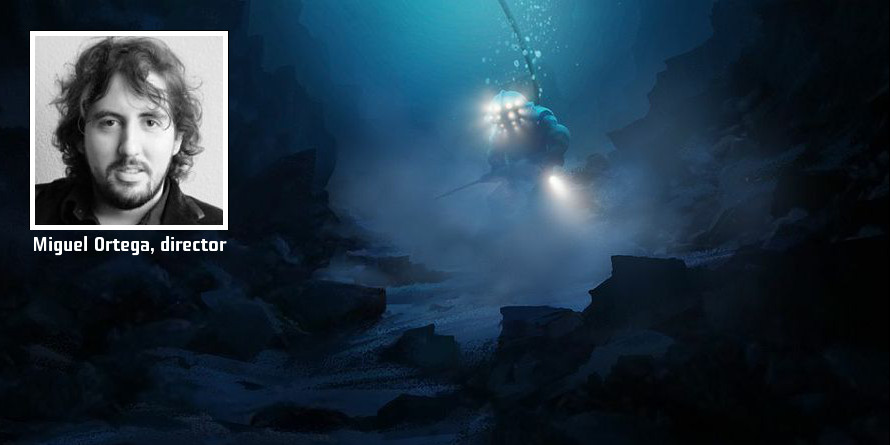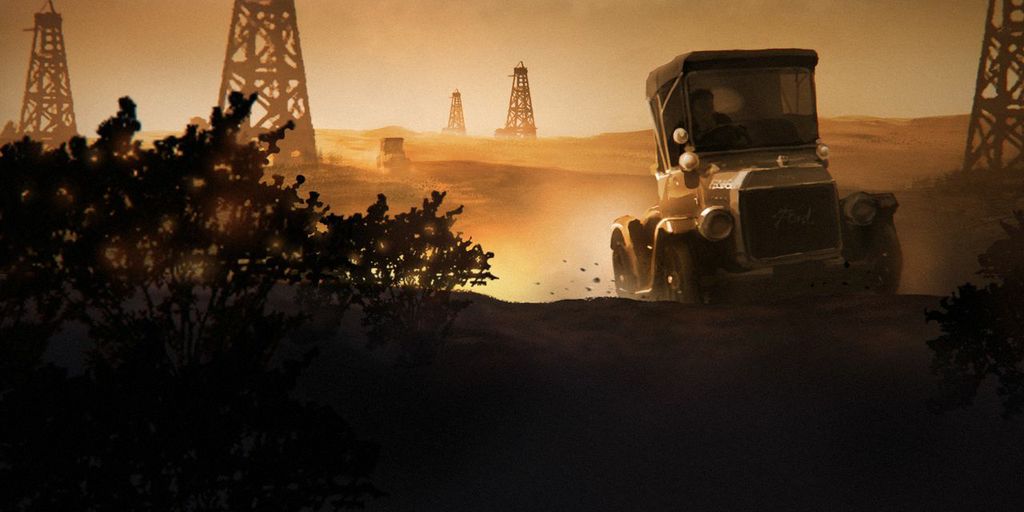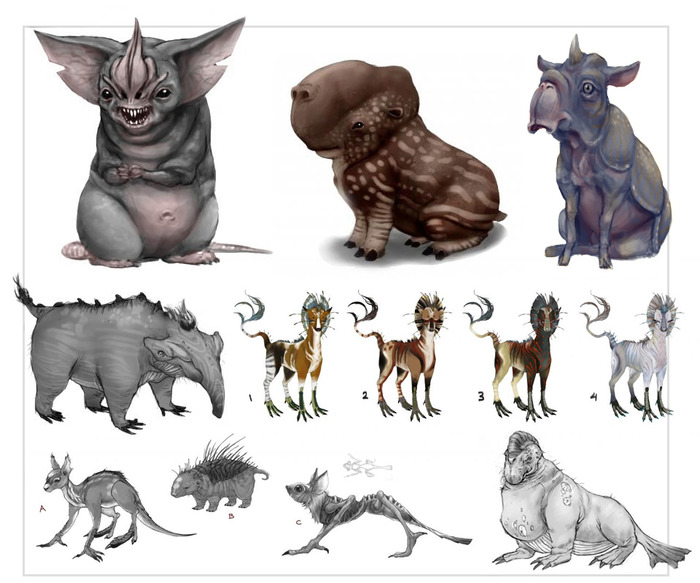VFX artist Miguel Ortega on the hunt for The Ningyo

To make The Ningyo, Miguel Ortega converted his entire house into a movie set. We caught up with the VFX-artist-turned-director to find out more about this Faustian tale of adventure, obsession – and underwater monster hunting.
Over the course of an eight-year career in VFX, Miguel Ortega has worked for some of the world’s leading studios, including Rhythm & Hues, Tippett Studio and Digital Domain, where he headed up the digital models department for the company’s Vancouver studio.
His first film, The Green Ruby Pumpkin – a fantastical collision of the Oz stories and The Addams Family, with a dash of Dr. Seuss thrown in – was created largely between the hours of 10pm and 4am after days spent on other people’s movies. Working with his partner and production designer Tran Ma and a small team of like-minded artists, Ortega created a three-minute mini-epic in his own front room. The short acted as a calling card to ace production house Spy Films, who signed Ortega as a director.
His latest project, The Ningyo, is the pilot episode of what Ortega hopes will become either an anthology series (“think The Young Indiana Jones Chronicles meets The Twilight Zone”) or a feature film. Created with the help of volunteers from studios including Capcom, Weta and Sony, and students at the Gnomon School of Visual Effects, this period tale of real-life monster hunters is once again being filmed largely in Ortega’s own house.
To mark the launch of The Ningyo’s Kickstarter funding campaign, we caught up with Ortega to find out more about the project, what drives him to such extraordinary lengths to make movies – and what it’s like spending months of your life sleeping in a bedroom that has been converted into a pre-World War I college professor’s office.
CG Channel: Let’s start with the obvious question. What’s The Ningyo about?
Miguel Ortega: We want to do a realistic take on old-school adventure films by telling a Faust-like tale within the world of cryptozoology: the search for mythological or unproven creatures. The turn of the last century was a very conflicted time for conservation – scientists often captured creatures dead rather than alive – so it’s a great canvas against which to tell the story.
I don’t want to give away too much of the plot, but we put together this summary for Kickstarter: “Dr. Marlowe, a paleontologist and professor, finds a piece of a map pointing to the place where the ningyo, a mythical Japanese creature, can be found. He presents the project to his peers, who mock and dismiss him as a fraud. He decides to risk everything and go after the ningyo on his own. What he does not anticipate is that, in his search, he will be confronted with a choice that puts the very foundations of his morality to the test.”
CGC: Which begs the question… what exactly is a ningyo?
MO: It’s something like a Japanese equivalent of a mermaid. According to legend, it brings remarkable longevity to whoever consumes its flesh, although not immortality. However, it also brings misfortune to those who do.

Tales of high adventure: the look of The Ningyo is inspired by the work of Godfather cinematographer Gordon Willis, with a touch of Paul Thomas Anderson’s There Will Be Blood.
CGC: On your last short, you namechecked Edward Gorey, Dr. Seuss, Charles Addams and Shel Silverstein as influences. What kind of look are you aiming for this time round?
MO: The look we want is Gordon Willis’s work all the way… maybe with some Christopher Doyle thrown in for good measure. I like darkness in photography, and I would be thrilled if we can get the feel of a film like There Will Be Blood.
CGC: How much of the episode will be CG?
MO: There will be six or seven digital creatures: some just in cages sleeping, but there will be two hero creatures. The diving suit will be all CG as well. Luckily, that kind of work is our background, so I’m not so worried about it.
Outside the creature work, we’re trying to keep the shot count down to make this manageable. We really are building as much as we can physically, not only to help with the aesthetics and performances but also because we don’t want to be still doing roto work in a year’s time.

Concept sketches for The Ningyo’s digital bestiary. Ortega expects the completed episode to feature six or seven digital creatures, including two hero characters.
CGC: Most of that building work is being done in your own house. What does it look like now?
MO: The living room has been converted to a giant hallway and our bedroom has been gutted and transformed into a college professor’s office circa 1909. Whatever other open space we used to have is either being used to store unused props or to restore found pieces. My favorites are a giant hippo skull and a turn-of-the-century revolver ‘rifle’ that I didn’t even know existed. I also got a taxidermied albino cobra from the 1960s, which I really like.
CGC: What’s it like living in a film set? Can you ever leave the characters behind and switch off?
MO: Never – nor do we want to. The advantage of working this way is we can constantly improve things and not be rushed because we’re paying thousands of dollars a day to rent a stage. If we ever ‘made it’, I would still like to work this way. It’s liberating.

Front-facing with fitted carpets and en suite greenscreen: for The Ningyo, Ortega has converted his entire house, including the bedroom, into sets and prop-storage areas.
CGC: How did you come to collaborate with Gnomon on The Ningyo?
MO: First and foremost, I’m an alumnus. I graduated eight years ago and I’ve always kept in touch with them. I was also a teacher there when I was living in Los Angeles.
After The Green Ruby Pumpkin, my first short, Alex Alvarez and Darrin Krumweide, Gnomon’s founders, offered me the resources to get the ball rolling on the next project: their greenscreen stage, their computers – hundreds rather than the six we had on TGRP – and if any students wanted to participate, they were free to do so according to their school schedule. Many were ex-students of mine, so it works out great. They keep me on my toes!
CGC: Who else is working on the project?
MO: Besides the Gnomon students, we also have a lot of professionals that liked what we did with The Green Ruby Pumpkin, and wanted to help out. We have some awesome artists from studios including Capcom, Weta, Digital Domain, Tippett and Sony, so we’re going to have quite a crew.
CGC: What will you be able to do on The Ningyo that you couldn’t last time round?
MO: The Green Ruby Pumpkin was three minutes long. This is 22 minutes, so that alone is a huge difference. We also have some amazing FX guys now that can do things I never could. On TGRP, our ‘FX department’ was a RED camera filming as I threw dust up and down in front of black fabric.
CGC: When you made The Green Ruby Pumpkin, you had a pretty cool day job – and I’d guess you were working some pretty intense hours. Why did you want to take on a short film on top?
MO: My job at Digital Domain was a dream come true – and yes, the hours were intense, because I was running the company’s digital models department in Vancouver. But I wanted to do more than just model and texture: I wanted to know how to do every task in the pipeline. Also, on a personal level, I felt the same larger issues facing our industry. I wanted to create my own content and control my own destiny. I didn’t want to work for someone else and be laid off when the film was completed.
CGC: Wanting to control your own destiny is one thing: working from 10pm to 4am night after night is another. How many hours did you put in on the film in total?
MO: It’s hard to say. There were times we were putting in so much overtime that we physically couldn’t work any more when we got home. We put in more time than I care to think about.
It was an exhausting experience, really painful. There were times when I would just stare into a wall and think it was never going to end. Those little kids asking for candy bled us both dry. But what can you do? We love this stuff, and if this is what it takes, then this is what it takes.
CGC: Making the move from VFX artist to director isn’t always easy. What were the lessons you learned on The Green Ruby Pumpkin?
MO: It’s difficult, no doubt. But that’s why it’s worth doing it, isn’t it? All the good stuff is hard to achieve.
First and foremost, this time round, we’re putting much more time into the story. We’re working with Gregory Collins, who’s a great writer. And on the technical side, we are more conscious of what things really take to get done. It’s easy to get this wrong when you work for a Digital Domain or Tippett Studio because you’re used to a huge crew, but when you are on your own project, things move much more slowly. It’s easy to understand how someone can get overwhelmed and quit halfway.
CGC: But some animators and VFX artists who did stick it out became great directors. How much of an inspiration for your work are people like Tim Burton or Neill Blomkamp?
I’m heavily influenced by early works of Tim Burton and his production designer Rick Heinrichs. Neill Blomkamp is very inspirational as well: I joined Spy Films in particular because he started his career directing with them.
As for non-VFX-related directors, I’d say the obvious: Disney, Spielberg, Del Toro, Wong Kar-wai, Scorsese, Coppola and, of course, George Lucas. Star Wars is still the foundation of why I do what I do.
Visit The Ningyo’s Kickstarter page
Full disclosure: CG Channel is owned by the Gnomon School of Visual Effects.
